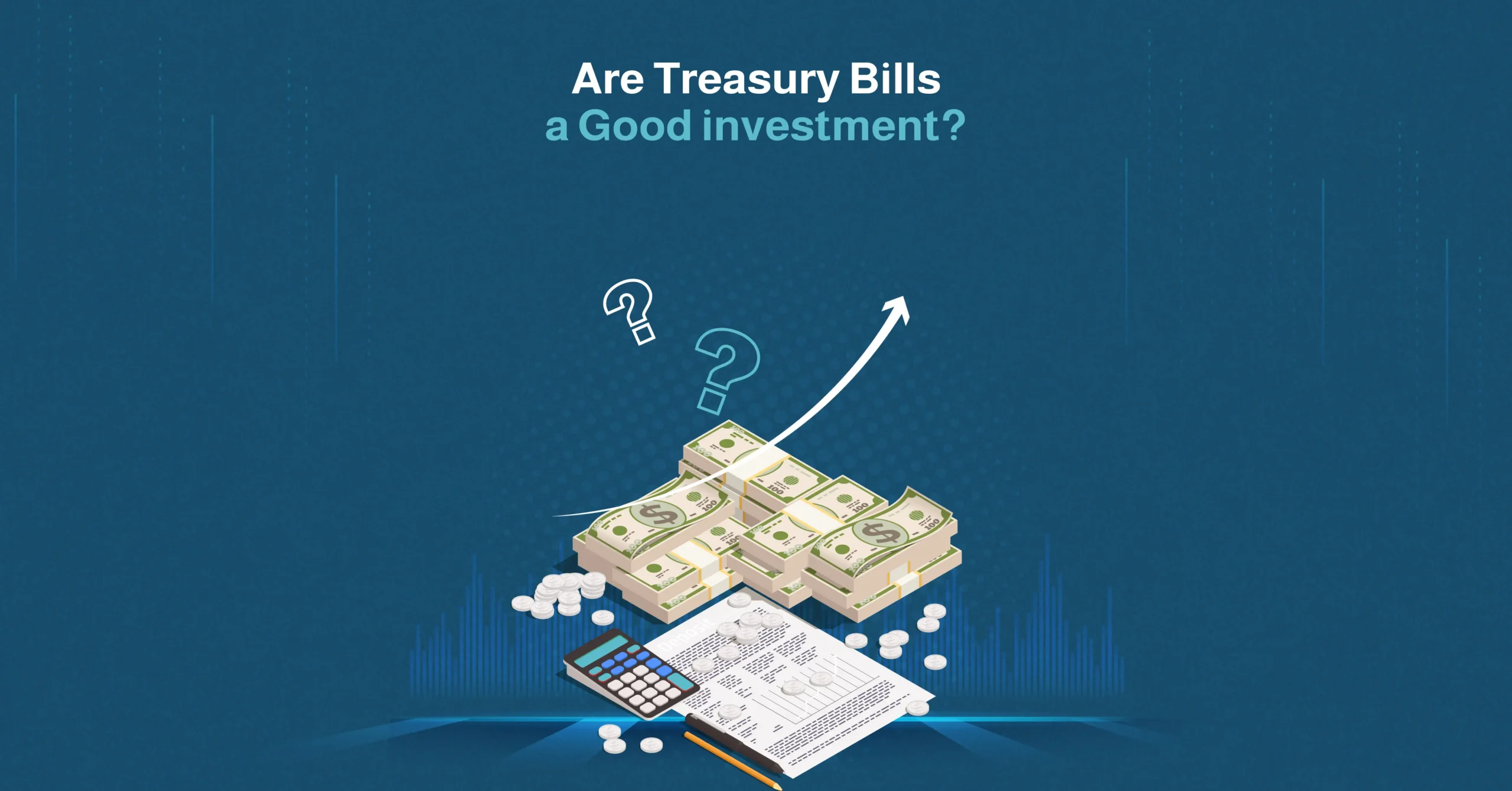The world of investing can feel daunting to the beginner or the cautious investor. Everyone knows a person who changed their life with one simple investment, but can never seem to name the person or provide details of the investment itself. Stocks, mutual funds, and cryptocurrencies all promise growth, but they come with risks that aren’t always the easiest to predict. So what we need is a simple solution, something low-risk; this is where treasury bills come in, sometimes called T-bills.
Treasury bills are short-term government debt instruments that pay a fixed return at maturity. This type of investment is backed by the government; therefore, it offers the investor a high level of security. But, are treasury bills a good investment in 2026? It is the question cautious investors are asking due to the ever-changing interest rates, inflation, and global economic uncertainty.
This article will guide you through the essentials of treasury bills. We will cover how they work, look at the benefits, including safety and liquidity. We will also look at any drawbacks, such as lower returns when compared to other options. We will look at practical comparisons with savings accounts and bonds, helping you discover whether treasury bills would fit your investment strategy for 2026.
To conclude, we will look at fiversifications, which include opportunities from platforms such as Gamma Assets that allow you to explore real-world, asset-backed options. By the end of this article, we hope that you have a clearer answer to the question: Are treasury bills a good investment for your financial goals this year?
More topics can be read on the Gamma blog
What Are Treasury Bills and How Do They Work?
Treasury bills are issued by the government and are short-term debt securities. Buying a treasury bill means you are lending money to the government for a fixed amount of time, which is usually anywhere from a week to a year. When the bill matures, the government will pay you back the full face value. That seems like a poor idea, but treasure bills are sold at a discount, meaning they are bought at less than their face value. A treasury bill may cost the investor 9,800 SAR but mature at 10,000 SAR. The difference in buying and maturing is your earnings, making treasury bills predictable. This is the main reason investors ask: Are treasury bills a good investment?
Maturities typically come in 4, 13, 26, or 52 weeks, which allows investors to choose their term that fits their financial goals. This shows that treasury bills are rather liquid, with many markets allowing them to be sold before they mature if need be. Safety is the main attraction with treasury bills; the government backing means that the default risk is very low, which makes this extremely attractive to both beginners and conservative investors. Investors should not expect the high returns seen by some stocks and bonds; their purpose lies in their predictability and security, making them a reliable choice for investors.
Key Benefits of Investing in Treasury Bills
There are several advantages to investing in treasury bills, making them appealing to beginners and cautious investors alike.
Safety and Government Backing:
Being that treasury bills are issued by the government, the risk of default is very low, making them one of the safest investment options available.
Predictable Returns
Treasury bills pay back a fixed amount at maturity. This means you know exactly how much you receive on maturity. This predictability is particularly valuable for investors who are looking for stability rather than high yet uncertain returns.
Liquidity
Treasury bonds have fixed terms and pay out a set amount at maturity, therefor are designed to be held until they mature. If the capital is needed before the term ends, the bills can be sold on a secondary market.
Accessibility
Treasury bills are fairly accessible for investors, as the minimum investment requirement is relatively low.
We have compiled a table to help you compare the options.
| Feature | Treasury Bill | Savings Account | Bonds |
| Safety | Very High (gov-backed) | High (bank-backed) | Varies (depends on the issuer) |
| Return | Predictable, modest | Low, variable | Moderate to high |
| Liquidity | Can sell before maturity | Generally high | Usually less liquid |
| Min. investment | Low | Low | Can be higher |
| Ideal for | Conservative investors, beginners | Short-term savers | Long-term growth seekers. |
This table highlights why treasury bills are so often chosen by those asking, Are treasury bills a good investment, especially if safety and predictability are priorities.
Drawbacks to Consider Before Buying Treasury Bills
Even though Treasury bills offer safety and predictability, they are not without their limitations; these should be kept in mind when deciding whether to invest in Treasury bills.
Lower Returns:
Treasury bills usually provide modest returns when compared to stocks or some bonds. For investors seeking significant growth, relying solely on treasury bills might not meet the long-term financial goals.
Inflation Risk:
One of the main concerns is that the fixed return of a treasury bill may not keep up with inflation. If inflation were to rise faster than the yield, the purchasing power of your money would decrease over time.
Opportunity Cost:
Money in a treasury bill may earn more invested elsewhere. Equities, corporate bonds, or real estate can offer higher potential returns, though those options have a higher risk potential.
Short-Term Focus:
Treasury bills are designed for short-term investment, which makes them less suitable for long-term wealth building. Investors who need growth over a couple of years would not opt for treasury bills as they are too limiting.
Practical Comparison:
Imagine a treasury bill offering 3% return while inflation is 4%. Even though the investment is safe, your earnings will be negative.
It is important that you consider these drawbacks when asking yourself: Are treasury bills a good investment? They can be a wonderful tool for preserving capital and managing risk, but they are not the best choice for high-growth goals.
Are Treasury Bills a Good Investment for You in 2026?
The answer to that question depends on your financial goals, time horizon, and risk tolerance. Treasury bills are an excellent choice for you as an investor if you are looking for or value the following:
- Want to protect your capital
- Prefer predictability in your returns over potentially higher but more volatile gains.
- Have a short-term savings goal, such as a major purchase within a year.
Treasury bills are less ideal if you:
- Need to outpace inflation for long-term wealth building
- Are comfortable with more risk for higher returns
- Have a multi-year investment horizon and can handle market fluctuations.
In 2026, the appeal of treasury bills will be heavily influenced by the movements of interest rates and inflation trends. While they work best as part of a diversified portfolio, treasury bills work well to park your capital. When asking yourself, ‘Are treasury bills a good investment?’ it is essential to match their characteristics to your needs and not rely on a one-size-fits-all option.
Balancing Treasury Bills With Diversified Assets Like Gamma Assets
When it comes to investing, no investment is truly risk-free, but some options are lower in risk. Treasury bills are one such option, as they provide security and liquidity, and when paired with a platform like Gamma Assets. Gamma Assets allows investors to diversify their portfolio with real-world assets and asset-backed opportunities. When you combine treasury bills with higher-yield investments, you can preserve wealth and still be aiming for growth. A balanced portfolio may include the following:
- Treasury bills for stability and liquidity
- Asset-backed investments for long-term growth potential
- Other fixed-income products for steady income
This mix would help reduce risk without sacrificing all opportunities for high returns. For the more cautious investors, this type of diversification can deliver peace of mind while still accruing wealth over time.
Treasury bills remain one of the safest ways to invest, offering government backing, predictable returns, and flexibility for the investor. They are well-suited for conservative investors, beginners, or anyone needing a low-risk place to hold their funds in 2026.
This safety does, however, have trade-offs. Lower returns and the risk of falling behind inflation need to be considered. For many, the best answer to “Are treasury bills a good investment?” lies in their use alongside a balanced portfolio. By diversifying, you can add asset-backed options through platforms like Gamma Assets for safety and to reach better returns.
By understanding the strengths and limitations of treasury bills, you can decide if they fit into your investment plan and how they can be paired with other opportunities to meet your financial goals.
You can start investing now from the Gamma Asset Investment Platform
FAQ
Are treasury bills better than bonds for beginners?
For beginners seeking simplicity and safety, treasury bills are often easier to understand and less risky than many bonds. They have shorter maturities, predictable returns, and minimal price fluctuations. Bonds can offer higher yields but come with greater risk and longer commitment.
Can I lose money investing in treasury bills?
Treasury bills are backed by the government, making default highly unlikely. However, you could lose purchasing power if inflation outpaces your returns. If sold before maturity, market conditions could slightly affect the sale price.
How do treasury bills compare to savings accounts or fixed deposits?
Treasury bills generally offer slightly higher returns than savings accounts but lower liquidity. Fixed deposits can have similar returns but often require you to lock in your money for a set term, with penalties for early withdrawal. Treasury bills balance safety with a clear, short-term commitment.













